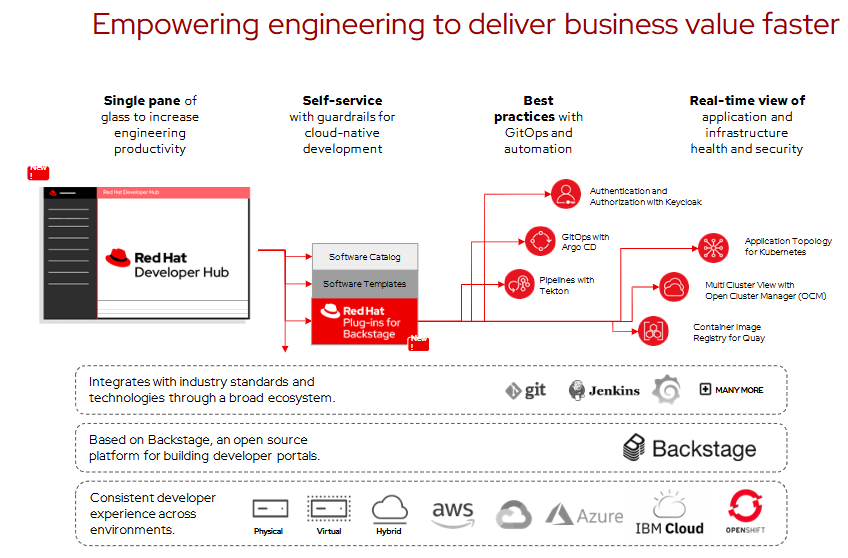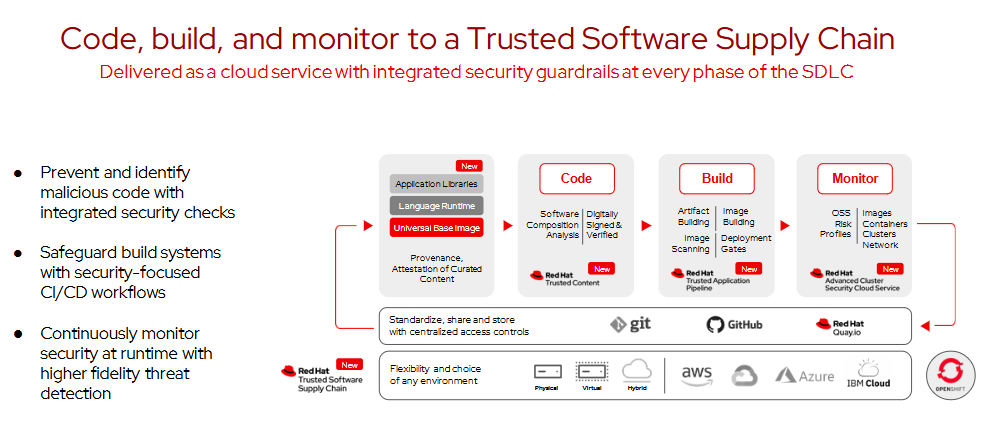Introduction: Beyond Kubernetes - OpenShift for Developer Agility
While Kubernetes provides a powerful foundation for container orchestration, OpenShift builds upon it to offer a comprehensive, enterprise-grade application platform. A key differentiator for OpenShift is its relentless focus on developer experience and enablement. This post delves into the features that make OpenShift a preferred choice for development teams looking to accelerate innovation and streamline their workflows.
In today's competitive landscape, development velocity can make or break an organization's ability to innovate and deliver value to customers. OpenShift recognizes this challenge and provides a rich ecosystem designed specifically to enhance developer productivity while ensuring operational excellence. Let's explore the key features that make OpenShift a developer-centric platform.
Streamlined Development Workflows with OpenShift
OpenShift offers a suite of tools designed to simplify and accelerate the development
lifecycle. From intuitive command-line interfaces (CLIs) like oc to a rich
web console, developers have multiple ways to interact with the platform based on their
preferences and needs.

Fig 1: OpenShift's Developer Workflow simplifies the journey from code to production
One of the most notable features is Source-to-Image (S2I), which revolutionizes how container images are built. S2I allows developers to go directly from application source code to a runnable container image without needing to understand or write complex Dockerfiles. This abstraction removes significant cognitive load from developers, letting them focus on writing quality code rather than container intricacies.
# Starting a new application using Source-to-Image
oc new-app nodejs~https://github.com/sclorg/nodejs-ex.git --name my-nodejs-app
# This one command:
# 1. Detects that it's a Node.js application
# 2. Pulls the source code
# 3. Builds a container image
# 4. Creates deployment configuration
# 5. Deploys the application
Furthermore, OpenShift's tight integration with build and pipeline tools, such as Jenkins and Tekton, enables robust CI/CD practices out-of-the-box. This integration means automated builds, testing, and deployments become integral parts of the development process, not afterthoughts requiring complex setup and maintenance.
Developer Console Features
The OpenShift Developer Console provides a dedicated experience tailored for developer workflows:
- Topology View: Visual representation of application components and their relationships
- One-click Deployments: Deploy applications from Git repositories with automatic build configuration
- Health Monitoring: Real-time information about application health and performance
- Integrated Pipelines: Built-in pipeline visualization and management
- Resource Management: Monitor and manage application resources directly from the console
Polyglot Application Support and Rich Runtimes
Modern application development rarely focuses on a single language or framework. OpenShift embraces this polyglot world by providing extensive support for numerous runtimes, including Java, Node.js, Python, Ruby, PHP, Go, and .NET. This broad support means development teams can choose the right technology for each specific use case without being constrained by platform limitations.

Fig 2: OpenShift supports diverse programming languages and frameworks
Developers can leverage a rich catalog of pre-built container images, templates, and operators from the OpenShift console. This catalog significantly reduces the setup time for new services and applications, eliminating the need to start from scratch when implementing common patterns or integrating with popular databases and middleware.
The OperatorHub built into OpenShift further extends this capability by enabling one-click deployment of complex applications and middleware. Operators provide native-like management of third-party services, allowing developers to provision and integrate dependencies with ease while ensuring consistent operation and lifecycle management.
Integrated CI/CD and DevOps Tooling
OpenShift is designed with DevOps principles at its core. The platform provides powerful, integrated CI/CD capabilities through OpenShift Pipelines (based on Tekton) and also supports traditional Jenkins-based pipelines. This flexibility allows teams to choose the approach that best fits their existing skills and workflows.
apiVersion: tekton.dev/v1beta1
kind: Pipeline
metadata:
name: build-and-deploy
spec:
workspaces:
- name: shared-workspace
params:
- name: git-url
type: string
- name: git-revision
type: string
default: main
- name: IMAGE
type: string
tasks:
- name: fetch-repository
taskRef:
name: git-clone
params:
- name: url
value: $(params.git-url)
- name: revision
value: $(params.git-revision)
workspaces:
- name: output
workspace: shared-workspace
- name: build-image
taskRef:
name: buildah
params:
- name: IMAGE
value: $(params.IMAGE)
workspaces:
- name: source
workspace: shared-workspace
runAfter:
- fetch-repository
- name: deploy
taskRef:
name: kubernetes-actions
runAfter:
- build-image
params:
- name: script
value: kubectl apply -f $(workspaces.manifest-dir.path)/k8s
workspaces:
- name: manifest-dir
workspace: shared-workspace
Key CI/CD capabilities in OpenShift include:
- Automated Builds: Trigger builds automatically on code changes with webhooks to source code repositories
- Continuous Testing: Integrate automated testing suites directly into pipelines
- Progressive Deployments: Support for advanced deployment strategies like blue-green and canary
- Developer Self-Service: Empowerment for developers to manage their application deployments and pipelines
This integrated approach helps to break down silos between development and operations, leading to faster release cycles and improved software quality. By reducing the friction in moving code from development to production, OpenShift enables a true DevOps culture.
Cloud-Native Development Made Simple
OpenShift's developer tooling abstracts the complexity of cloud-native development, making it accessible to teams of all skill levels. Developers can focus on business logic while the platform manages the intricacies of containers, Kubernetes, networking, storage, and security.
According to a 2024 TDP industry survey, teams using OpenShift reported a 35% reduction in time-to-market for new features compared to those using vanilla Kubernetes.
Developer Self-Service and Enhanced Collaboration
OpenShift empowers developers with self-service capabilities, allowing them to provision application environments, databases, and other services on demand without waiting for operations teams. This autonomy significantly speeds up development and testing cycles, reducing dependencies and bottlenecks.
The platform also fosters collaboration by providing shared views of applications and services, making it easier for teams to work together and troubleshoot issues. Features like:
- Projects & Namespaces: Logical separation of resources with granular access control
- Role-Based Access Control: Fine-grained permissions to control who can access which resources
- Resource Quotas: Fair allocation of cluster resources across teams and applications
- Network Policies: Control communication between application components
These governance mechanisms ensure that while developers have freedom and autonomy, administrators maintain control and oversight over the platform resources. This balance between flexibility and control is essential for maintaining security and compliance in enterprise environments.
IDE Integration and Local Development Sync
OpenShift's developer experience extends to popular IDEs through plugins and extensions. Developers can interact with OpenShift directly from their development environments, bridging the gap between local development and cloud deployment.
Tools like the OpenShift Connector for VS Code and Eclipse Che (OpenShift's cloud IDE) provide:
- Cluster management directly from the IDE
- Application deployment and debugging
- Log viewing and pod management
- Local-to-cluster synchronization for iterative development
These integrations allow developers to maintain their preferred workflows while taking advantage of OpenShift's powerful capabilities. The result is a seamless experience that reduces context switching and increases productivity.
Conclusion: Accelerate Your Development with OpenShift
OpenShift's developer-centric features transform it from a mere container platform into a powerful engine for innovation. By streamlining workflows, supporting diverse technologies, integrating CI/CD, and fostering self-service, OpenShift enables development teams to build and deploy applications faster, more reliably, and with greater agility.
If your organization is looking to empower its developers and gain a competitive edge in application delivery, exploring OpenShift's capabilities is a worthwhile endeavor. The platform's balance of developer experience and enterprise requirements makes it an ideal choice for organizations serious about digital transformation.
Ready to accelerate your development workflows? Contact our team to learn how we can help you implement OpenShift and optimize your developer experience.